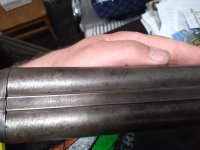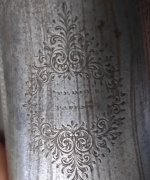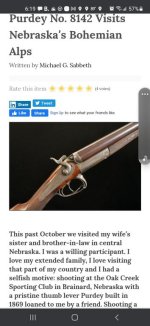I can recommend Classic Gunstocks LLC in Oswego, NY
Classic Gunstocks, Llc - Online
They do outstanding work.
The Purdey in question can certainly be brought back to life. The issues mentioned are not roadblocks by any stretch. It's just that you need some one that understands that the gun needs proper gunsmithing and is not a parts exchange item.
The bbls can be damascus re-finished after the dents are removed and any clean up polishing done inside.
Make sure the wall thickness is checked all the way along the barrels.
Many of these older guns have been honed out over their life time and they can be very thin in spots.
While there is no minimum wall thickness when it comes to the Proof House standards,,most shooters want the minimum wall thickness out at the forend area to be at least .014".
That's awfully thin,,I would pass on one that thin, but many will accept bbls that thin out at the end of the forend and shoot away.
Also check the orig Proof marks for chamber length. Then check the actual chamber length in the bbls to see if they have been altered/lengthened.
In an English gun, if they have been altered,, the gun is 'Out of Proof',,and that is a BIG deal with a Brit shotgun. A big value drop.
Honing out the bores is another one,,if the bores are honed out over a certain number of .ooo" more than what they left the proof house with,,again the gun is Out of Proof. Instantly the hands of rejection go up and if you are going to sell the gun, it has gun leprocy. No one wants to touch it.
The hammers would be repaired by welding, reshaping, re-engraving if needed and then rehardening (casehardening).
If the entire action and parts were to brought back to 'new' look, the colors would be left as that. If the newly colored hammers were to match the frame and parts as they now look,,mostly worn,,then that is how the new hammers would be 'taken back' to match.
The same process with any other damaged parts on the gun.
Some parts are orig case colored, some were charcoal blued. A few were polished and left 'in the white' when orig made.
Time and use has worn and taken those colors to a different stage now. You have to decide wether you want a real 'restoration' or a 'make it like new' do-over.
If you send the gun to England for the work,, the gun will be sent to the Proof house (London or Birmingham) for re-proof because of bbl repair.
There it will undergo standard proofing using smokeless proof rounds,,the same proof ammo that every other modern shotgun gets fed.
No whimpy proof rounds for older & damascus guns. They treat them all the same.
The stock work is straight forward. Cracks repaired, reinforcement splices sometimes made for strength, but nothing should show on the outside when done.
This is 'Old Growth' English Walnut and you want to preserve that wood at all costs. No room for mistakes.
There's likely some very fancy gained wood underneath years of oil and grime. They didn't skimp on wood quality.
The first step is removing any old soaked in oil from the wood. No baths of acetone here, no overnite success tricks to it. The laborious process of using Whiting Powder to draw the oil out is the general rule.
Stock finish,,the Purdey used what they called Slacum Oil finish back them. Actually till quite later as well. A mixture of Linseed oil, turpentine and wax.
All heated to mix. The components and amts can differ from user to user as well as the application methods.
More of a black art to apply than a plain how-to instruction sheet.
Wether that is used to restore the finish or a more modern finish is used, the result should be the look of the original Purdey finish.
No spray on look, no lacquer, ect.
Repairs to locks can be as simple as fixing up internal screw heads. Yes they get the one size fits all screw driver blade treatment as well sometimes.
The lock parts are always very highly polished,,or 'Benched' as they say.
Precision fitted, they often just need to be cleaned and repolished for good working order.
A replaced mainspring is not all that uncommon especially on the right lock.
If it isn't quite the same shape as the orig on the left side, a new one can be made from scratch,,there's no ordering a Purdey mainspring from Track of the Wolf.
Making springs can be expensive but if you really want a true restoration (inside and out) that is what would be called for.
Checkering can be recut. Being that old, hand made tools were the thing of the day. So a modern DemBart might not slip right into place and recut the pattern. Their 26 LPI might really be a 27.
You start to cut across lines when using a 26LPI tool. Some modern single line tools have an adj guide on them so you can make the LPI anything you want. The electric checkering machines are all adj guides.
Not many will want to go after a Purdey stock with a whizzing electric checkering machine in hand..but they are very efficient and the pattern is cut straight and then finished up by hand.
I don't take in any restoration work anymore. But here are a few pics of a Purdey I restored a couple yrs back.
This is the type of work the gunsmith(s) will get into in a restoration. So you can see why it can get expensive.
I would expect that anyone would want to do a hands-on inspection before commiting to a price for the work.
There are so many hidden variables involved. Things like bbls being off-face can really run the $$ upward.
Safe to say you are looking at 5K and up for what you want to do.
****
This was a 1896 vintage Purdey IIRC.
A hammerless, and a spring assisted opener.
2 Bbl set 16ga.
The action colors were worn but no re-case coloring was called for.
Most of this job was wood work with some small metal repair and restoration.
The stock and forend were badly oil soaked and cracked at many points.
One set of bbls refused to go on the frame w/o so stubborn effort.
The forend iron attachment was heavily rusted, locks needed disassembly and cleaning. Some rust but they cleaned up nicely.
Wood was recheckered after a refinish. Checkering was a combination of 26 and 28lpi in the pattern.
The trigger guard had been buff polished and reblued at some time in the past.
So I re-polished it and then re-cut the engraving. Then reblued to correct era color.
Most of the screws needed fixing, recutting and recoloring to match their place in the frame or part.
Pics not in any sort of order.





You can see how the upper arm of the mainspring is used to power the Assisted Opener feature of the gun

Probably the orig engravers initials there around the trigger guard attachment hole.

Wood de-oiled,,now you can start to see some nice grain. You can also see the damage better.

Forend needed a repair piece added.


Not much left of the checkering here either. Just starting to sharpen up the 'tear-drops'.

Rust and crud everywhere. Inside of forend iron. Spring loaded F/E attachment devise.

Nice piece of wood hidden inside there.















